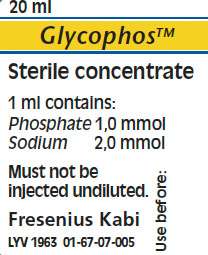Glycophos
Glycophos
FULL PRESCRIBING INFORMATION
1. QUALITATIVE AND QUANTITATIVE
COMPOSITION
1 ml of Glycophos contains
Active ingredient Quantity
Sodium glycerophosphate pentahydrate 306.1 mg*
*Corresponds to 216 mg sodium glycerophosphate
The active ingredient in 1 ml of Glycophos correspond to
Phosphate 1 mmol
Sodium 2 mmol
For excipients, see 5.1
PRODUCT PROPERTIES
• Osmolality: 2760 mosm/kg water
• pH: 7.4
2.
PHARMACEUTICAL
FORM
Concentrate for solution for infusion.
3. CLINICAL
PARTICULARS
3.1 Therapeutic indications
Glycophos is indicated in adult patients and infants as a supplement in intravenous nutrition to meet the requirements of phosphate.
3.2 Posology and method of administration
Glycophos must not be given undiluted.
Adults:
The recommended dosage is individual. The recommended daily dosage of phosphate during intravenous nutrition would normally be 10-20 mmol. This can be met by using 10-20 ml of Glycophos added to the infusion solution or to the admixture for which compatibility has been proved.
Infants:
The recommended dosage is individual. The recommended dose for infants and neonates is 1.0-1.5 mmol/Kg body weight/day.
3.3 Contra-indications
Glycophos should not be given to patients in a state of dehydration or with hypernatraemia, hyperphosphataemia, severe renal insufficiency or shock.
3.4 Special warnings and special precautions for use
Glycophos should be used with caution in patients with impaired renal function. The phosphate status of all patients should be monitored regularly.
Glycophos must not be given undiluted.
3.5 Interaction with other medicaments and other forms of interaction
No interactions with other drugs have been observed, but a moderate fall in serum phosphate can be seen during carbohydrate infusions.
3.6 Pregnancy and lactation
Animal reproduction studies or clinical investigations during pregnancy have not been carried out with Glycophos. However, the requirements of phosphate in a pregnant woman are slightly increased compared to non-pregnant women.
No adverse events are to be expected when Glycophos is administered during pregnancy.
3.7 Effects on ability to drive and use machines
No effects on the ability to drive and use machines are to be expected.
3.8 Undesirable effects
No adverse effects related to glycerophosphate have been reported.
3.9 Overdose
No adverse effects of an overdose have been reported. Most patients in need of intravenous nutrition have an increased capacity to handle glycerophosphate. See also 3.3 "Contra-indications".
4. PHARMACOLOGICAL PROPERTIES
4.1 Pharmacodynamic properties
Glycerophosphate is a metabolic intermediate in fat metabolism and any pharmacodynamic effects other than maintaining the normal metabolic pathways are unlikely.
4.2 Pharmacokinetic properties
To become available it is necessary for the phosphate group to be hydrolysed from the glycerophosphate molecule. The hydrolysis occurs maximally at a plasma concentration of >0.7 mmol/l. Assuming that all hydrolysis of glycerophosphate takes place in plasma, about 12-15 mmol of sodium glycerophosphate will be hydrolysed each day in individuals with normal serum alkaline phosphatase.
No pharmacokinetical data is available for infants, however with the recommended dosage hyperphosphataemia is unlikely.
4.3 Preclinical safety data
Preclinical safety studies on Glycophos demonstrated good tolerance.
5. PHARMACEUTICAL PARTICULARS
5.1 List of excipients
Hydrochloric acid
Water for Injections
5.2 Incompatibilities
Glycophos may only be added to or mixed with other medicinal products for which compatibility has been documented. See 5.6.
5.3 Shelf life
3 years
5.4 Special precautions for storage
Do not store above 25°C. Do not freeze.
5.5 Nature and contents of container
Polypropylene vial.
Pack size: 10 x 20 ml
5.6 Instructions for use/handling
Glycophos must not be given undiluted.
Compatibility
Additions should be made aseptically.
Up to 120 ml of Glycophos and 48 mmol of calcium (as CaCl2) can be added to 1000 ml Vamin Glucose, Vamin 9 Electrolyte Free, Vamin 14, Vamin 14 Electrolyte Free, Vamin 18 Electrolyte Free and Vaminolact.
Up to 10 ml of Glycophos and 10 mmol of calcium (as CaCl2) can be added to 1000 ml Glucose 50 mg/ml.
Up to 20 ml of Glycophos and 20 mmol of calcium (as CaCl2) can be added to 1000 ml Glucose 200 mg/ml.
Up to 60 mmol of Glycophos and 24 mmol of calcium (as CaCl2) can be added to 1000 ml Glucose 500 mg/ml.
Infusion time
The infusion time should not be less than 8 hours.
Stability
When additions are made to an infusion solution, the infusion should be completed within 24 hours from preparation to prevent microbiological contamination. The left over contents of opened bottles/vials/ampoules should be discarded and not kept for later use.
PACKAGE LABEL - PRINCIPAL DISPLAY PANEL - Glycophos 20 mL Vial Label20 ml
Glycophos™
Sterile concentrate

PACKAGE LABEL - PRINCIPAL DISPLAY PANEL - Glycophos 20 mL Vial Carton Panel
10 vials of 20 ml
Glycophos™
Sterile concentrate

GlycophosSODIUM GLYCOLATE INJECTION, SOLUTION
| |||||||||||||||||||||||||||||||||||||||||||||||||||||||||||||